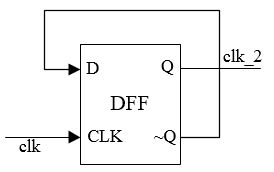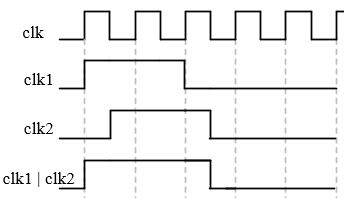WeiLin

End of Best.
vlog_day11:时钟分频
by WeiLin
时钟分频分为:偶数分频、奇数分频
1.偶数分频

二分频用一个触发器即可实现:
module clk_2(
input clk,rst_n,
output reg clk_out
);
always@(posedge clk or negedge rst_n)begin
if(!rst_n)
clk_out<=0;
else
clk_out<=~clk_out;
end
endmodule
大于2的偶数分频就需要用到计数器了:
module clk_even #(parameter N=4)(
input clk,rst_n,
output reg clk_out
);
localparam n=N/2;
reg [3:0] cnt;
always@(posedge clk or negedge rst_n)begin
if(!rst_n)begin
cnt<=0;
clk_out<=0;
end
else if(cnt==n-1)begin
cnt<=0;
clk_out<=~clk_out;
end
else begin
cnt<=cnt+1;
clk_out<=clk_out;
end
end
endmodule

2.奇数分频
奇数分频需要在上升沿和下降沿分别计数,然后”错位相或”或者”错位异或”即可,所以可以分成以下两个方法(以5分频为例):
方法1:错位相或

module clk_odd1 #(parameter N=5)(
input clk,rst_n,
output clk_out
);
localparam n=N/2;//对于N=5,n=2
reg [3:0] cnt;//只需1个计数器就可以
reg clk1,clk2;
always@(posedge clk or negedge rst_n)begin
if(!rst_n)
cnt<=0;
else
cnt<=(cnt==N-1)?0:cnt+1;
end
always@(posedge clk or negedge rst_n)begin
if(!rst_n)
clk1<=0;
else begin
if(cnt==0 || cnt==n)
clk1<=~clk1;
else
clk1<=clk1;
end
end
always@(negedge clk or negedge rst_n)begin
if(!rst_n)
clk2<=0;
else begin
if(cnt==1 || cnt==n+1)
clk2<=~clk2;
else
clk2<=clk2;
end
end
assign clk_out=clk1 | clk2;
endmodule

方法2:错位异或

module clk_odd2 #(parameter N=5)(
input clk,rst_n,
output clk_out
);
localparam n=N/2;
reg [3:0] cnt;
reg clk1,clk2;
always@(posedge clk or negedge rst_n)begin
if(!rst_n)
cnt<=0;
else
cnt<=(cnt==N-1)?0:cnt+1;
end
always@(posedge clk or negedge rst_n)begin
if(!rst_n)
clk1<=0;
else begin
if(cnt==0)
clk1<=~clk1;
else
clk1<=clk1;
end
end
always@(negedge clk or negedge rst_n)begin
if(!rst_n)
clk2<=0;
else begin
if(cnt==n+1)
clk2<=~clk2;
else
clk2<=clk2;
end
end
assign clk_out=clk1 ^ clk2;
endmodule
